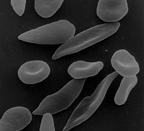Huntingdon's Chorea
1. Genetic Causes:
The gene that causes the disease is found at the tip of chromosome-4. It leads to
damage to some of the nerve cells in the brain. It is not known what the gene's usual function is and how it causes the disease.
The disease is caused by a dominant gene: therefore anyone who has the carrier gene gets the disease; and their offspring have a 50% chance of catching it as well (assuming that only one of the genes is faulty).
2. Symptoms:
Symptoms generally appear between 30 and 50 years of age, but can appear as young as two and as old as 70. It progresses over a 10 to 25 year period.
It causes progressive deterioration of both physical and mental abilities. This is caused by the loss of cells in a part of the brain called the basal ganglia. This cell damage affects the mental ability (thinking, judgment and memory), movement and emotional control of a sufferer.
The symptoms appear gradually, usually in midlife, between the ages of 30 and 50. However, the disease has been known to strike young children as well as the elderly.
The main symptoms are:
Depression and bad mood swings (sufferers can be aggressive, anxious, irritable, impulsive and unsociable), involuntary movements, slurred speech and poor judgement (there is a poor organizational ability, and intellect and shot-term memory are affected), and, difficulty with swallowing and a intoxicated (drunken) appearance (sufferers can become restless, and experience difficulty with basic motor skills and twitch a lot, developing into larger involuntary movements, affecting balance, walking, speech and swallowing abilities in later forms of the disease. An inability to walk or speak well in the late stages of the disease means sufferers often lose their independence.
3. Life expectancy:
Complications associated with...


